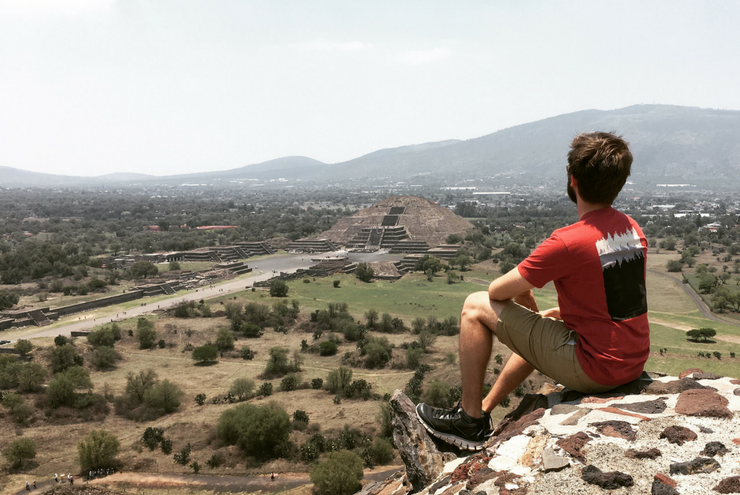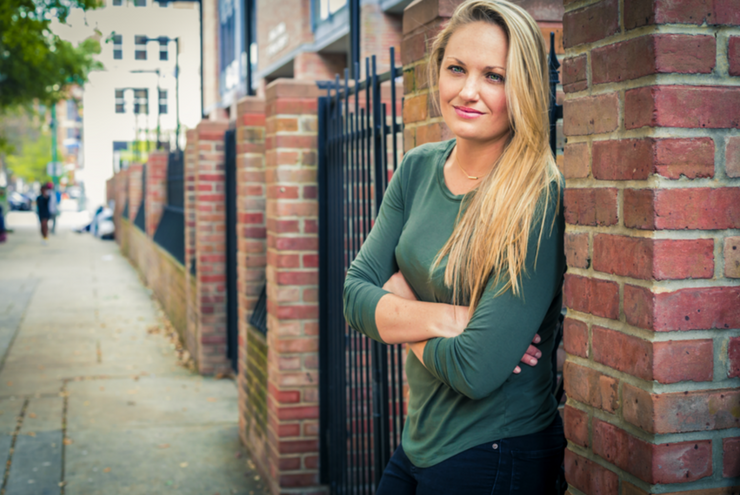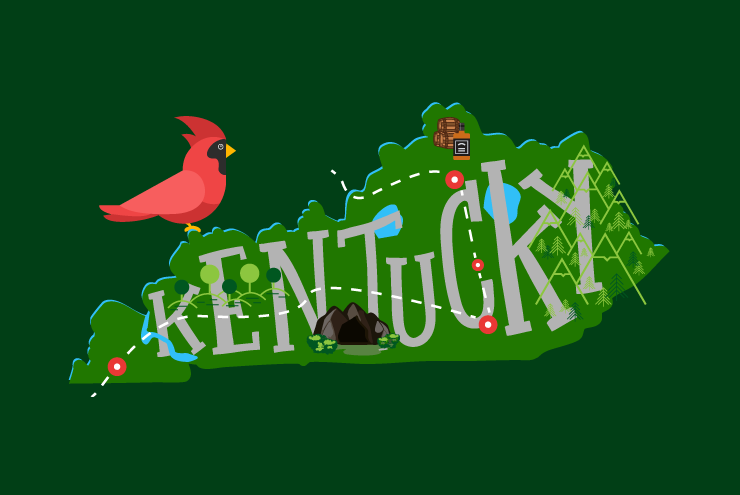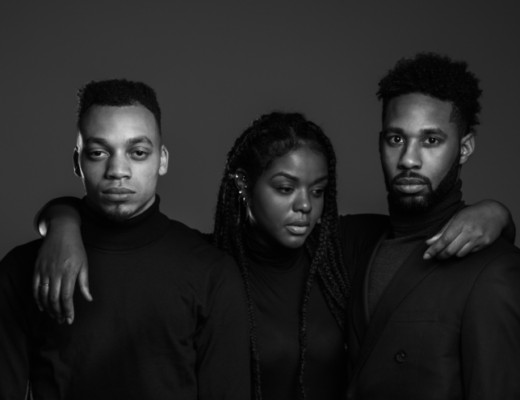By Josh Inocéncio
“No way,” I groaned from the hotel bed as my skin squirmed with chills. “There’s no way I have Montezuma’s Revenge. Not after all the street shit and creepy crawlies I ate in Guadalajara and Seoul a few years back.”
I boast an easy tan (and I thought an iron stomach) that’s no doubt because of the Mexican drips of blood in my body, but my fairer skin and blonde hair speedily betray my Austrian and Appalachian roots. Hours later, I hurled a swirl of green chunks into the porcelain sink and a gag that burned two generations back.
For half a century before my first visit to the Mexican capital, my Austrian grandma, Fritzi, toured the country, all the way down to Michoacán and Mexico City, to see her husband’s homeland. She, too, got sick and whittled her weight down on the journey.
But the history of my family (and an outrageously cheap Expedia deal) is why I ventured to Mexico City in May, to finally look upon the sites that compose a whole third of my ancestors. And though Montezuma’s Revenge confined me to an entire day of gulping peach Pedialite and binging Master of None, I still paid pilgrimage to everything I wanted to see. From the Catholic cathedrals to the Teotihuacan pyramids to Frida Kahlo’s studio, my three friends and I spent five full days delighting in Mexico City’s offerings.
The flight to Mexico City is less than two hours from Houston and Bush airport has plenty of early voyages. We arrived in the city by 10 a.m., our hotels in the Centro Histórico by 11:30 a.m., and we had sampled our first street tacos by the Zócalo square by noon. The day included walking over to the 17th century Metropolitan Cathedral, the Supreme Court justice building brimming with Jose Clemente Orozco murals, and a cab ride over to the Basilica de Guadalupe about 30 minutes north of the Centro Histórico.
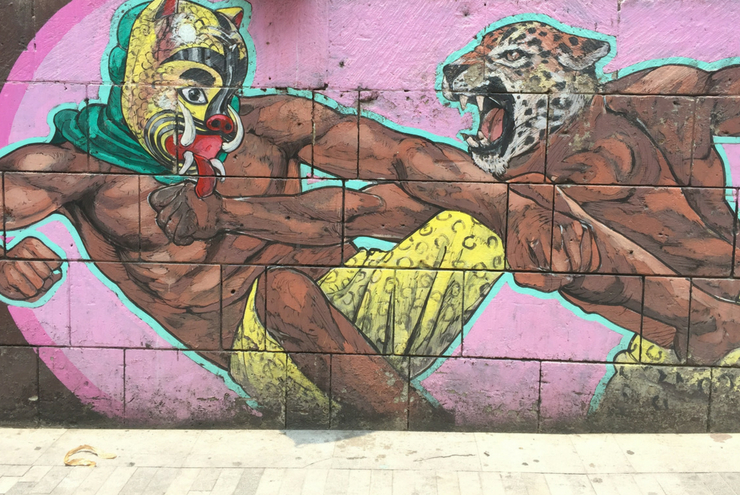
A colorful street mural outside of a Centro Histórico market. Photo by Josh Inocéncio.
Seventy years ago, my great-grandpa Jesus Ynosencio dug his knees into the dirt and crawled to the Basilica de Guadalupe in Mexico City. This was the eve of America’s role in Europe during World War II, and Jesus, a strawberry farmer, wanted to prevent his sons, immigrants to the United States, from going to battle overseas. His prayers to La Virgen weren’t answered, and Jesus’s three sons (including my grandfather José) traded wartime for U.S. citizenships. All three men survived, and a decade later, my grandfather moved with his Austrian wife, Fritzi (whom he met while he was stationed in Linz), to Texas. And during her road-trip with his family to Mexico City, she saw the same Basilica.
In 2017, the Basilica complex that my great-grandfather and grandmother visited in the 1940s and 1950s has transformed with a new sanctuary, finished in 1976, that houses La Virgen’s shawl. In Mexican tradition, the shawl of La Virgen is a sacred imprint of the visit between Juan Diego—the first Nahuatl convert to Catholicism after Hernan Cortes defeated Tenochtitlan—and the Virgin Mary. According to Mexican lore, however, it wasn’t just La Virgen that visited Juan Diego, but the indigenous goddess Tonantzin in disguise. Many Nahuatl folk and Mesoamerican enthusiasts maintain she dressed as the Virgin Mary to ease tensions between the Spanish and Indian populations.
Within the Basilica, Catholics still crawl on the marble floor from the first pews to the altar that contains the sacred shawl. I didn’t join the knee-bound pilgrims, but I did leave with two rosaries for my Grandma Fritzi and me. Neither of us are Catholics, but we do appreciate our histories.
The next day, the four of us ventured over to Museum of Anthropology in Chapultepec. The first floor of the museum contains 12 halls that cover the pre-Columbian history of various indigenous societies. On the second floor, 12 corresponding halls demonstrate contemporary life for indigenous tribes across the country. (Housed in the central Mexica hall is a replica of Emperor Montezuma’s headdress as the original is too fragile to transport from its current home in Vienna—an ethnic irony not lost on me.) Then, following a late lunch in the Polanco neighborhood walking distance from the museum, we took an Uber to Frida Kahlo’s house.
Tucked in the Coyoacan neighborhood just thirty minutes south of Centro Histórico is the Museo Frida Kahlo, which is the former home of Frida and Diego Rivera. The museum includes the guest room where Leon Trotsky stayed when he fled the nascent Soviet Union, a kitchen with Frida’s mole recipe posted on the doorway, her painting studio with the mirror she used for self-portraits, and her bedroom with an urn containing her ashes still on the dressing table.
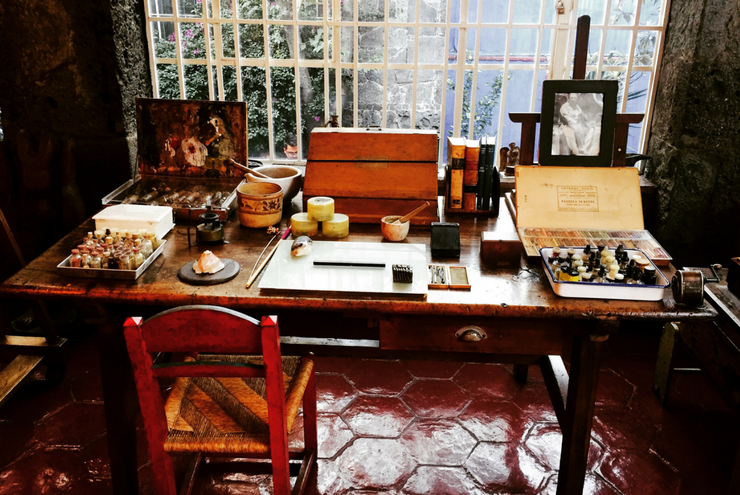
The Museo Frida Kahlo, the former home of Frida and Diego Rivera, features the artist’s desk, painting studio, and dressing table. Photo by Josh Inocéncio.
After you exit the house, there’s an almost-secret exhibit around the corner from the gift shop. Pushing apart black curtains, viewers will find the indigenous-inspired dresses that Frida wore to presence her Mesoamerican identity. But there’s also an extended exhibit, with materials hidden for many years, on the accouterment she wore at first to correct her uneven legs after suffering polio as a child, and then to stabilize her body after her 1953 accident where doctors amputated her leg. In the final four years of her life, she continued to paint from a wheelchair (which is in her studio).
On our third day, we hired an Uber for the nearly two-hour drive north of Mexico City, and my two years studying Mesoamerican myths as a graduate student at Florida State flooded back to my memory as my friends and I hiked the Pyramid of the Moon, the Temple of the Feathered Serpent, and the Pyramid of the Sun. We didn’t book the trip to be among the final hikers to these pre-Aztec pyramids, but we discovered that, after 2017, tourists are no longer allowed to hike the structures. And the Teotihuacan pyramids aren’t the only pyramids that are closing to tourist hikes.
Unfortunately, altitude sunburn mixed with a jolt of Montezuma’s Revenge slayed me the evening we returned from the pyramids. But, in the name of history, my eyes—as well as my stomach—relived the journeys before me to Mexico City.
A few other stops thrown in, such as the Palacio Nacional and the Templo Mayor, made for a perfect week in an international city that is at once indigenous and Catholic, Latin American and European. Like New York or London, the streets whir with Dutch, Italian, German, French, and Japanese as travelers from the world over bustle in to see the western hemisphere’s largest city.


